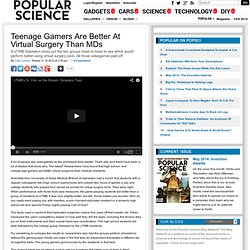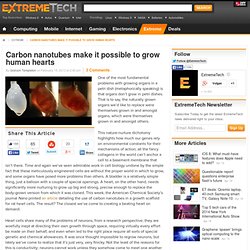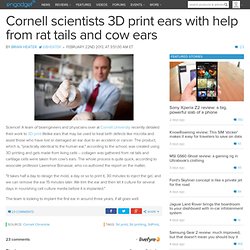

Teenage Gamers Are Better At Virtual Surgery Than MDs. A lot of people see videogames as the archetypal time-waster.

That's silly, and there have been a lot of studies that show why. The latest? Researchers have found that high school- and college-age gamers are better virtual surgeons than medical residents. Scientists from University of Texas Medical Branch at Galveston had a hunch that students with a regular videogame diet (high school sophomores who played two hours of games a day and college students who played four) would be primed for virtual surgery tools.
Headless Kenshiro muscle-bot gets ripped at the gym. Is a robot with muscles and bones any more freaky than one with servomotors?

Researchers at the University of Tokyo have been building a humanoid robot called Kenshiro that moves around with muscles that work with small pulleys. Initially developed as a scrawny kid-bot in 2001, Kenshiro has been packing on muscle mass. Rheinmetall 50kW laser weapon aces latest test, pew-pews a 3-inch ballistic target. A Manmade Island to Store Wind Energy. This illustration shows how the artificial island would use pumped hydro energy storage where water is pumped to a reservoir during off-peak times and released to a lower reservoir later to generate electricity.

Perhaps it’s not surprising that people from countries with experience holding back the sea see the potential of building an artificial island to store wind energy. Belgian cabinet member, Johan Vande Lanotte, has introduced a planning proposal for a man-made atoll placed in the North Sea to store energy. The idea is to place the island a few kilometers off shore near a wind farm, according to Vande Lanotte’s office. When the wind farm produces excess energy for the local electricity grid, such as off-peak times in the overnight hours, the island will store the energy and release it later during peak times. It would use the oldest and most cost-effective bulk energy storage there is: pumped hydro. Scientists 3D-print embryonic stem cells, pave the way for lab-made organ transplants.
Envisioning the urban skyscraper of 2050. Carbon nanotubes make it possible to grow human hearts. One of the most fundamental problems with growing organs in a petri dish (metaphorically speaking) is that organs don’t grow in petri dishes.

That is to say, the naturally grown organs we’d like to replace were themselves grown in and amongst organs, which were themselves grown in and amongst others. This nature-nurture dichotomy highlights how much our genes rely on environmental constants for their mechanisms of action; all the fancy collagens in the world can’t anchor a cell to a basement membrane that isn’t there. Time and again we’ve seen admirable work in cell biology undone by the simple fact that these meticulously engineered cells are without the proper world in which to grow, and some organs have posed more problems than others. A bladder is a relatively simple thing, just a balloon with a couple of special openings.
NASA’s cold fusion tech could put a nuclear reactor in every home, car, and plane. The cold fusion dream lives on: NASA is developing cheap, clean, low-energy nuclear reaction (LENR) technology that could eventually see cars, planes, and homes powered by small, safe nuclear reactors.

When we think of nuclear power, there are usually just two options: fission and fusion. Fission, which creates huge amounts of heat by splitting larger atoms into smaller atoms, is what currently powers every nuclear reactor on Earth. Fusion is the opposite, creating vast amounts of energy by fusing atoms of hydrogen together, but we’re still many years away from large-scale, commercial fusion reactors. Microchip implant lets blind patients see shapes, skip the prosthetic. Cornell scientists 3D print ears with help from rat tails and cow ears.
Science!

A team of bioengineers and physicians over at Cornell University recently detailed their work to 3D print lifelike ears that may be used to treat birth defects like microtia and assist those who have lost or damaged an ear due to an accident or cancer. The product, which is, "practically identical to the human ear," according to the school, was created using 3D printing and gels made from living cells -- collagen was gathered from rat tails and cartilage cells were taken from cow's ears. The whole process is quite quick, according to associate professor Lawrence Bonassar, who co-authored the report on the matter, "It takes half a day to design the mold, a day or so to print it, 30 minutes to inject the gel, and we can remove the ear 15 minutes later.
We trim the ear and then let it culture for several days in nourishing cell culture media before it is implanted. " Scientists Turn Cells into Living Computers. By modifying a genetic toggle switch, synthetic biologists at MIT have found a way to perform logic functions inside of living cells.

Based on plasmids, circular strings of DNA, scientists devised and inserted 16 different DNA strings into cells, one for each of the binary logic functions allowable in computation. " The key to the system is the use of recombinase enzymes, which cut and rearrange promoter and terminator DNA sequences to turn them on or off. In other words, recombinase enzymes are the inputs that determine whether the output gene is transcribed. " Synthetic biology seeks to bring concepts from electronic engineering to cell biology, treating gene functions as components in a circuit.